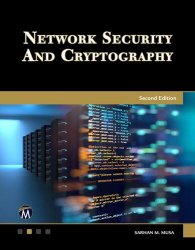 Название: Network Security and Cryptography: A Self-Teaching Introduction, 2nd Edition Название: Network Security and Cryptography: A Self-Teaching Introduction, 2nd Edition
Автор: Sarhan M. Musa
Издательство: Mercury Learning & Information
Год: 2022
Страниц: 611
Язык: английский
Формат: pdf (true)
Размер: 20.3 MB
This new edition introduces the basic concepts in computer networks, blockchain, and the latest trends and technologies in cryptography and network security. The book is a definitive guide to the principles and techniques of cryptography and network security, and introduces basic concepts in computer networks such as classical cipher schemes, public key cryptography, authentication schemes, pretty good privacy, and Internet security. It features a new chapter on Artificial Intelligence security and the latest material on emerging technologies, related to IoT, cloud computing, SCADA, blockchain, smart grid, Big Data analytics, and more. Primarily intended as a textbook for courses in computer science, electronics & communication, the book also serves as a basic reference and refresher for professionals in these areas.
Features:
Includes a new chapter on artificial intelligence security, the latest material on emerging technologies related to IoT, cloud computing, smart grid, big data analytics, blockchain, and more
Features separate chapters on the mathematics related to network security and cryptography
Introduces basic concepts in computer networks including classical cipher schemes, public key cryptography, authentication schemes, pretty good privacy, Internet security services, and system security
Includes end of chapter review questions
Chapter 1 is an overview of computer networks that defines its various terms and concepts. It also covers the Open Systems Interconnection (OSI) Model, the Transmission Control Protocol/Internetworking Protocol (TCP/IP) Model, the Hierarchical model, computer network equipment, computer network types, and computer network topology.
Chapter 2 covers the mathematical foundations for computer networks including probability fundamentals, random variables, discrete probability models, continuous probability models, transformation of random variables, generating functions, central limit theorem, classification of random processes, statistics of random processes and stationary, time averages of random processes and Ergodicity, multiple random processes, sample random processes, and Kendall’s notation.
Chapter 3 is an overview of cryptography that defines its various terms and concepts. It also covers the genetic model of secure communication, OSI security architecture, security attacks, security services, security mechanisms, categorization of security attacks, categorization of cryptographic systems, symmetric encryption model, link encryption, end-to-end e ncryption, and traffic pattern confidentiality.
Chapter 4 covers the mathematical foundations for cryptography including groups, rings, integral domain and fields, modular arithmetic, residue classes, primes and co-primes, the Euclidean Algorithm and the extended Euclidean Algorithm, the Galois Field, Fermat’s little theorem and its corollaries, Euler’s totient function, Euler’s theorem, prime numbers, discrete logarithms, primitive roots, primality testing, and Chinese remainder theorem.
...
Chapter 13 covers system security including intrusion, intrusion detection techniques, password management, malicious programs, different phases in the life of a virus, types of virus and antivirus scanners, worms, firewalls (characteristics, types, and configurations), and trusted systems.
Chapter 14 provides the security aspects of emerging technology. It contains big data analytics, cloud computing, Internet of Things (IoT), the Smart Grid, supervisory control and data acquisition (SCADA), control systems, and wireless sensor networks (WSN).
Chapter 15 is an overview of perspective and ideas on Artificial Intelligence (AI) security. It covers Machine Learning (ML), types of ML, Deep Learning (DL), and types of DL, AI for Intrusion Detection System (IDS).
Скачать Network Security and Cryptography, 2nd Edition
|